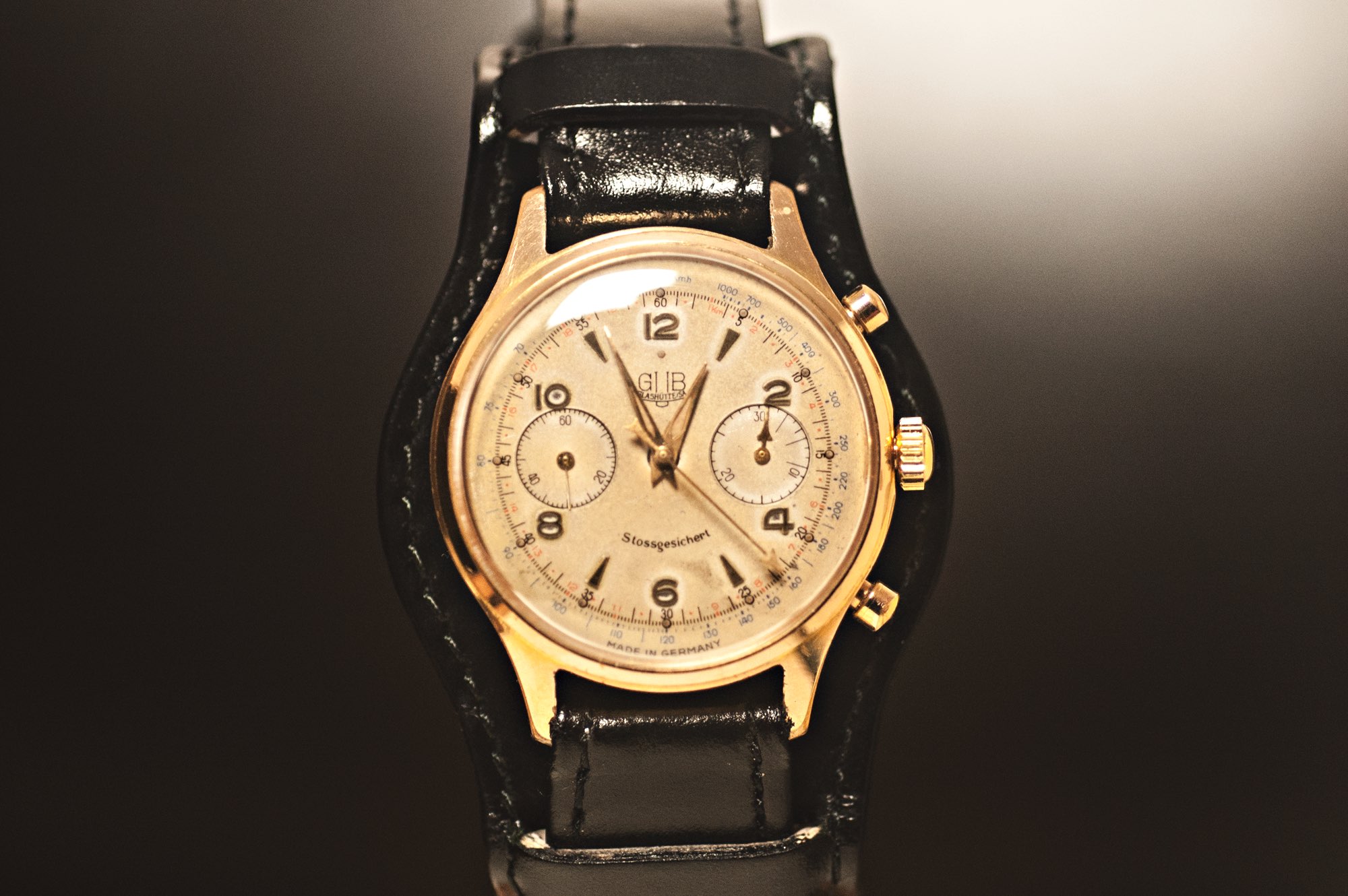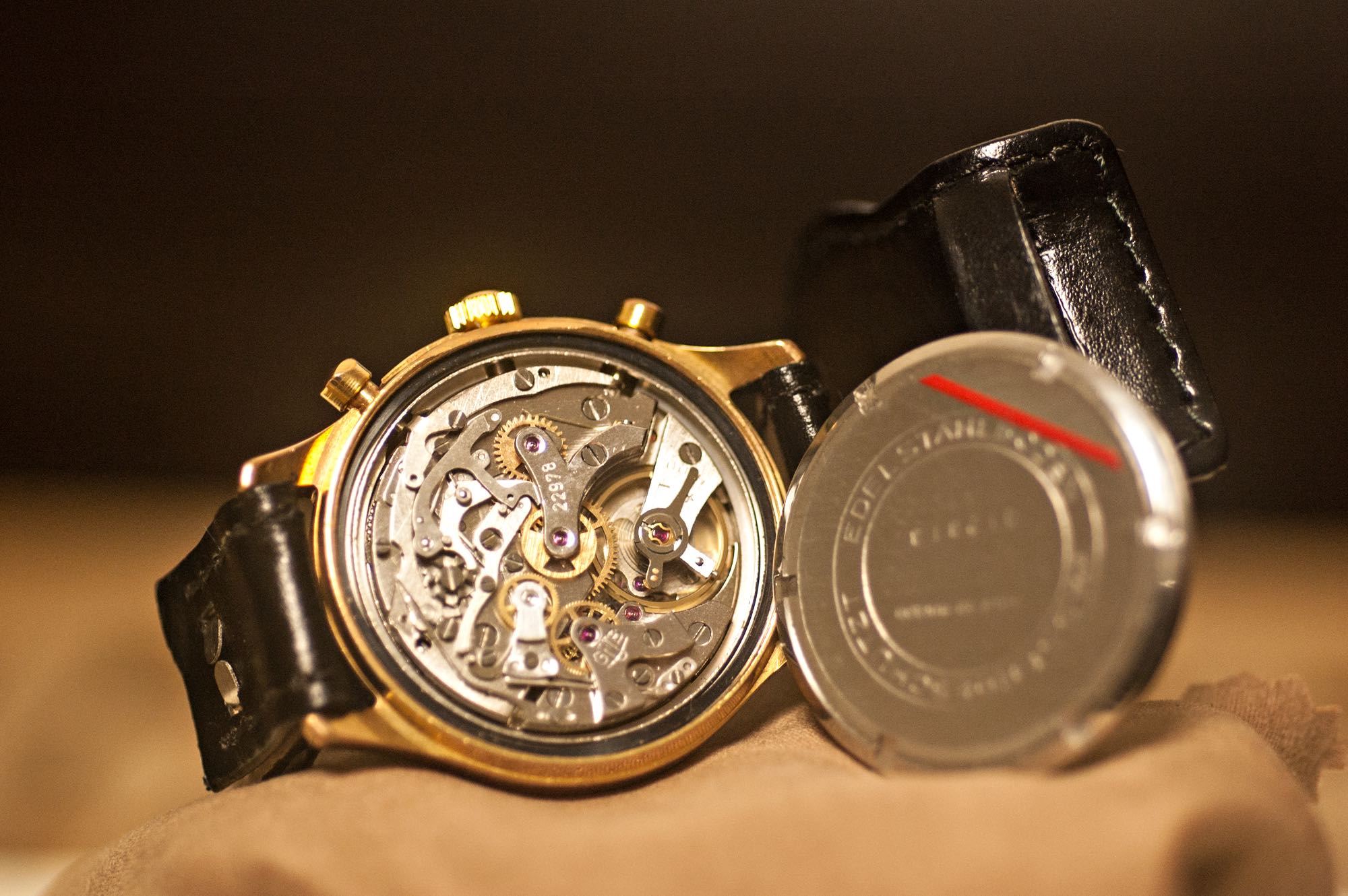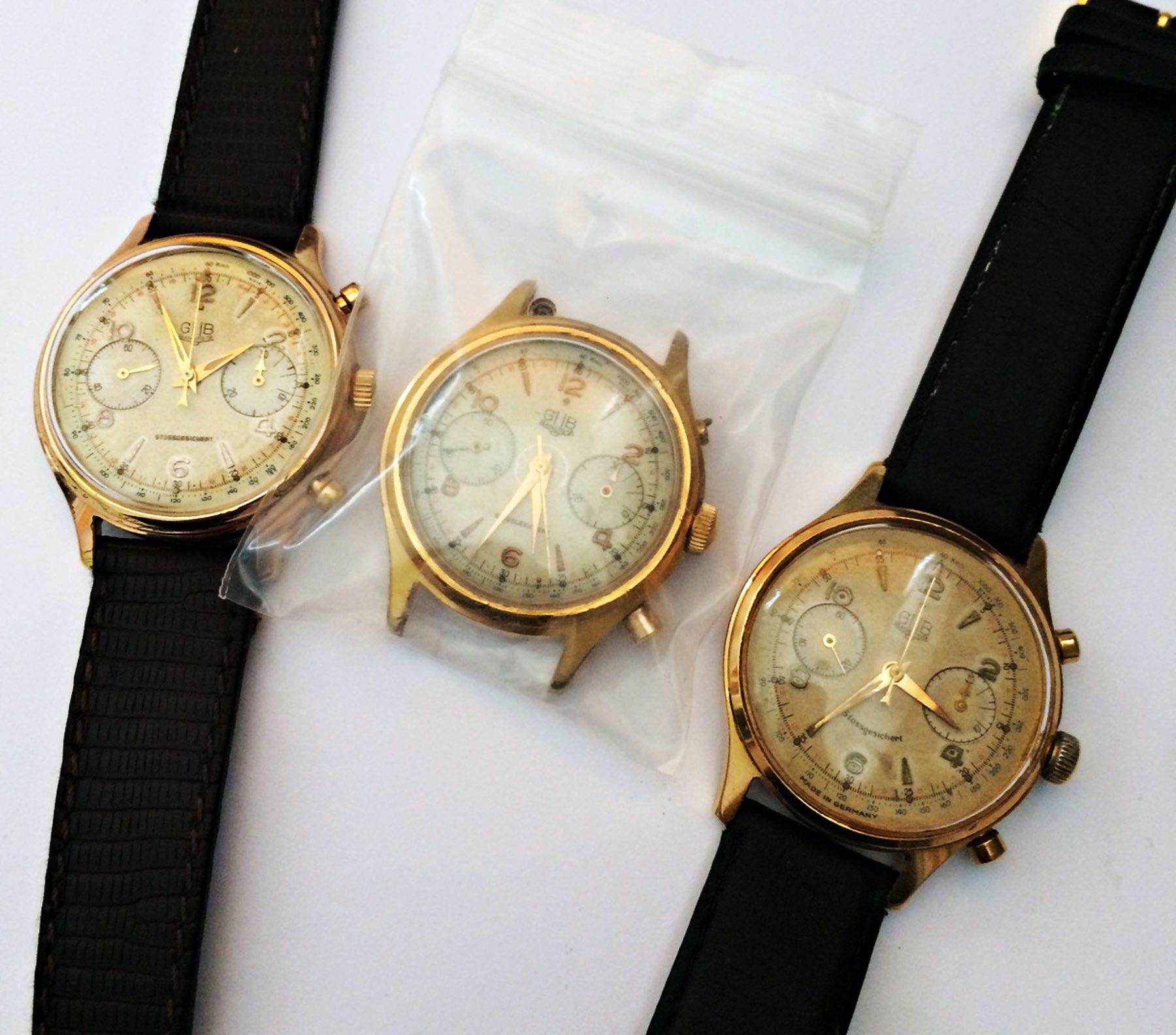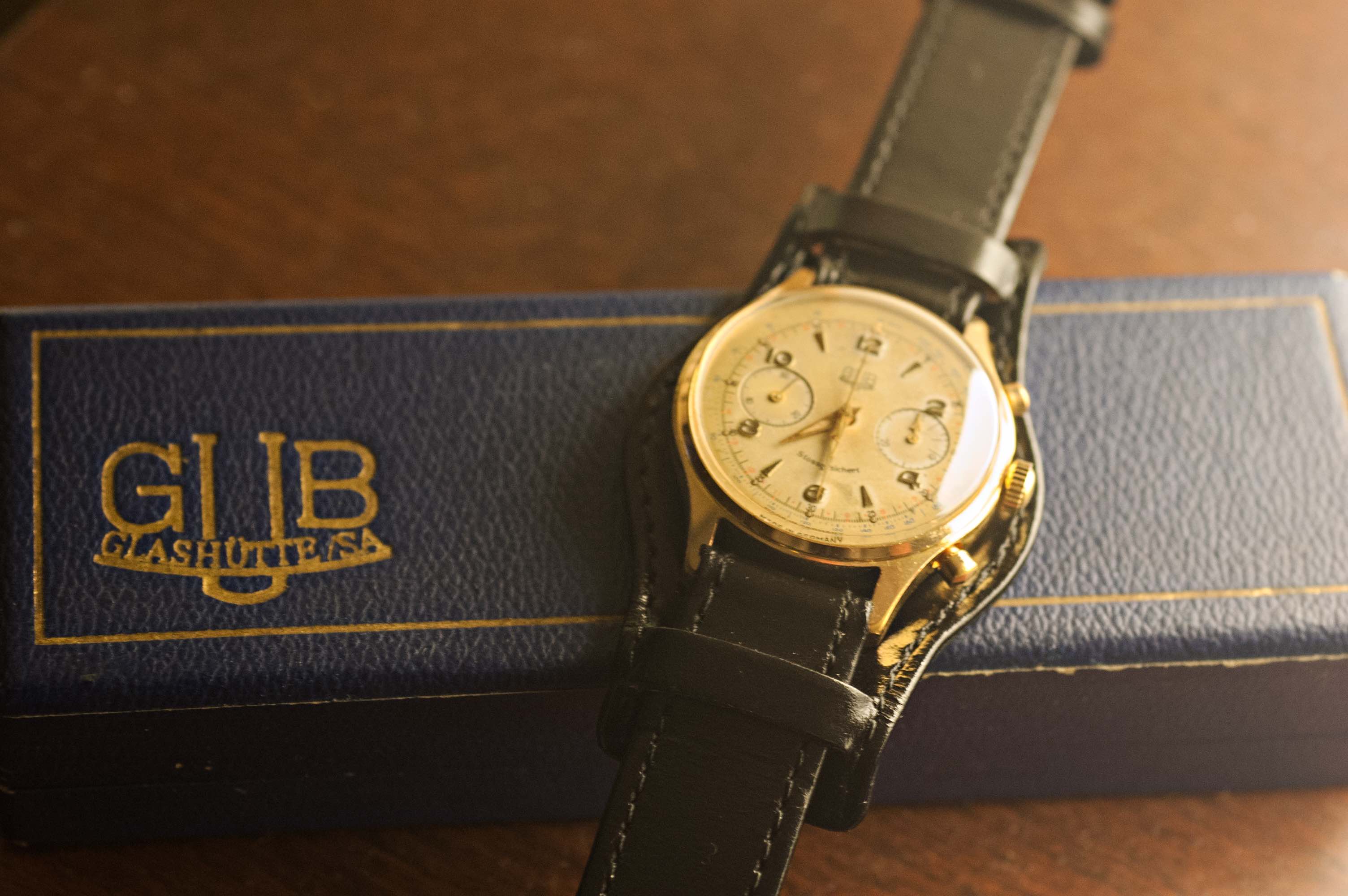The GUB Stossgesichert (Shockproof) Calibre 64 – the Eastern Block Military Pilot Watch that Never Was
A watch too elegant to be worn by military pilots.

This watch, the GUB Stossgesichert, was produced behind the Iron Curtain between 1954 and 1961, by what was left of the German watch industry after World War II and war reparations had stripped them of their assets. A number of companies grouped together under the name GUB (Glashütter Uhrenbetriebe or Glashütte Watch Companies) in 1951 to produce German watches again, including the venerable A. Lange & Söhne based in Glashütte, the home of German watchmaking. Here, I have spent some time researching what really is the story behind this interesting yet confusing old relic of the GDR. When these quirky watches started turning up online in the early 2000s, the collecting community assumed it was a watch produced for the Eastern Block Military – mainly because of its movement, the Calibre 64, a movement that derived from watches produced for the Luftwaffe during WWII.
The Calibre 64 is a smaller version of the Urofa calibre 59, which can be found in Luftwaffe Tutima and Glashütte pilot chronographs from WWII. What was a little confusing about the watch was that most examples appeared to have gold-plated cases, unlike the War Time watches that were finished in matte silver. Clearly not typical for a military-issued watch, more often seen with brushed or sometimes matte-coated steel to avoid glare and reflection. There are five different known variants in 35mm or 37mm cases, which were chrome-plated or 20 microns gold plated. The earlier watches featured small chronograph pushers, were offered with white and black dials. The black dials had large luminous Arabic numbers filled with radium (typical of 1950s watches). Perhaps it was created as a diplomatic or military service commemorative gift. Something for ‘Ace’ fighter pilots who were deemed worthy of a special award, thus associated with military aircraft combat and navigation.

The watch is a chronograph with a flyback function. This means that once running, the chronograph can be reset by only pressing the lower push-button (at 4 o’clock) allowing for consecutive timings, without having to perform the classic stop-reset-start sequence. This is a highly useful mechanism, mostly found in pilot’s watches – allowing fast corrections, particularly important if flying in formation during periods of bad weather and poor visibility.
The flyback function was already utilized by German WWII pilots with their Hanhart, Tutima and Glashütte signed watches, equipped with Hanhart calibre 40 and Urofa calibre 59 movements respectively. In fact, it appears that post-war, the Hanhart’s stock of movements was sent to France, where they were used to produce flyback chronographs for the French Aéronavale, with the mid-1950s Vixa Type 20.
Most of the stock of Tutima and Glashütte movements Urofa/Ufag went to the Moscow Watch Factory as part of war reparations but perhaps the manufacture’s original tooling did not. As we have said, the movement featured in this GUB Stossgesichert is almost the same as the original Urofa calibre 59, found in watches branded Tutima, Glashütte, sometimes with sterile dials or Russian brands – see the comparison image below.

These dials may have been blanks that did not end up being branded as it was an unnecessary extra process for what really was a pilot’s tool. However, the GUB Stossgesichert calibre 64 watches were made by the same watchmakers, in the same place, only smaller in size at 28mm instead of 34 mm with the production starting some five years after the end of WWII. Tutima produced the “Tempostopp” in 2017 to celebrate its 90th Anniversary and this elegant, high-end watch featured a movement based on the architecture of the Urofa Calibre 59.

The GUB Stossgesichert itself is quite light in weight, as it is made of a brass base metal coated with a thin (20 micron) gold layer. Its diameter is 37mm across. The cases apparently were imported from France, Besançon, home of the French watch industry at the foot of the Jura mountains. However, in my opinion, having handled lots of Eastern block and Swiss watches, the case seems well below that of the Swiss/French industry quality. The Calibre 64 was initially produced without the Western designed Incabloc Shock Protection system. That particular technical advancement was later incorporated into the design. This was either copied by GUB or was smuggled ‘over the wall’ as the technical advancements of the West were not available to the East during the Cold War.
When you open a Swiss watch of the same era – or most watches produced in the West – you’ll see a movement holder ring that is neat and custom-made to the case. Not with these German watches. They certainly work well, keep good time, run near to the desired 36h power reserve but they just feel a little light, less well built. The dial finishes seem like paper print and the hands are basic stamped metal. Eastern Germany was particularly under-resourced after the Berlin Wall was erected in 1961 and, while unable to trade with the West, they went without the basics we took for granted.
So what about this GUB Stossgesichert? What about this watch that combines the best of German manufacturing in the 1950s, its hand-wound chronograph flyback movement, serious military aviation application, but also a design that looks too dressy to be a proper field watch?
The thought is that the watch was purely for civilian use and was an export product sold into the internal market of the Eastern Bloc, which is probably true – and the GDR had the most successful economy of these countries while still paying war reparations to Soviet Russia. I have read also that this watch was gifted to high ranking military personnel and even a story of a military pilot wearing one while on a joint exchange, post the fall of the Berlin Wall in 1989.
I did find this watch included in what I consider the German military-watch Bible Militäruhren by Konrad Knirim, as GUB made many timepieces for the NVA (National People’s Army). I know from research that the military members have always been close to the watchmaking world so I think the odd pilot and Squadron Commander wore one of these watches. I’m sure middle-ranking political officers wore them, as did local members of the Communist Party. Perhaps a particularly important civil servant or factory director wore them for the glory of hitting their yearly quota. My opinion from all of this research leads me to believe that they were used by both GDR civilians and NVA personnel. The GUB calibre 64 is an interesting piece for the military collector who is prepared to wander off the beaten track to acquire one.









2 responses
Fascinating write up. I have had a suspicion since Glashutte Original introduced the SeaQ as the first watch in their Specializt range that a pilot’s watch may come next. This watch could be due a come back this year.
Went To East Berlin several times in early 80’s but the watches I remember were not worth the hunt so to speak..(Boy was I wrong for they would be collector pieces nowadays ).I did however pickup a DDR compass which I still use today…Go figure…